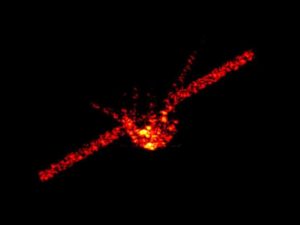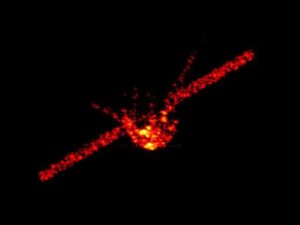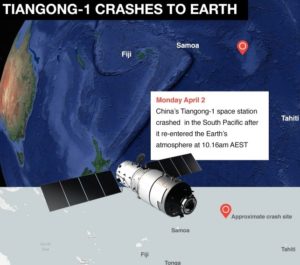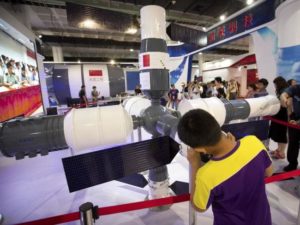
A Sigh Of Relief As Chinese Spaceship Crashes On Earth Without Any Loss Reported
The defunct Tiangong-1 space station of China has finally crashed onto the Earth after re-entering Earth’s atmosphere as watchers tried to see the happening.

The space agency of China CMSEO (China’s Manned Space Engineering Office) has confirmed the reports relating to the re-entry of the space station into the earth’s atmosphere with its mostly burned up body.
The crash site is the South Pacific with the timing recorded as 10.16 am AEST.

As expected earlier, only 10 per cent of the bus-sized, weighing 8.5-tonne spacecraft may have survived after most of it being burned-up upon its re-entry with mainly its heavier components being left out.
According to the statement issued by the US Strategic Command’s Joint Force Space Component Command (JFSCC), the re-entry of the space station was confirmed by the way of coordination with several counterparts from Australia, Canada, France, Germany, Italy, Japan, South Korea, and the UK.
The space station crashed at north-western side of Tahiti.
Jonathan McDowell, an astronomer with the Harvard-Smithsonian Center for Astrophysics said: “North-west of Tahiti – it managed to miss the ‘spacecraft graveyard’ which is further south!”
The Chinese space office had confirmed shortly before that it was already expected to re-enter of the Brazillian coast in the South Atlantic near the cities of Sao Paulo and Rio de Janeiro.
As per the available information about the space stations’ orbit, it would have re-entered to Earth somewhere 43 degrees north and 43 degrees south, a range which covers mostly the parts of United States, China, Africa, Southern Europe, Australia and South America.
The Space Craft would have caused no damage during and after its crash, but the disintegration part of the crash may have mimicked meteor shower, according to Chinese authorities.
Scientists have already mentioned that the falling debris may pose a slight risk for the people on the ground. The probabilities of the debris hitting any single person were considered to be less than one in a trillion.
The director of Beijing Planetarium, Dr Zhu Jin, said that the chances of anyone being hit by a single piece from the falling debris were those who may win a lottery.
“The high speeds of returning satellites mean they can travel thousands of kilometers during that time window, and that makes it very hard to predict a precise location of reentry,” said Holger Krag, head of the ESA’s Space Debris Office, in recent comments posted on the agency’s website.
The ESA added that the space station would likely crash over water, which has coverage for most of the planet’s surface.
There is nothing to for people to worry about; the China Manned Space Engineering Office stated earlier on its WeChat social media account.
Such falling spacecraft do “not crash into the Earth fiercely like in sci-fi movies, but turn into a splendid (meteor shower) and move across the beautiful starry sky as they race towards the Earth”, it said.

Launched back in 2011, Tiangong 1 was China’s first prototype space station, serving as an experimental platform for much larger projects, such as the Tiangong 2 launched in September 2016 and a planned future permanent Chinese space station. The station had already been a host to two crewed missions and served as a testing platform for perfecting docking procedures and many other operations.
You May Also Read: All Eyes Set For Chinese Space Lab Crash, ISRO Too Burnt Night Oil To Keep Vigil